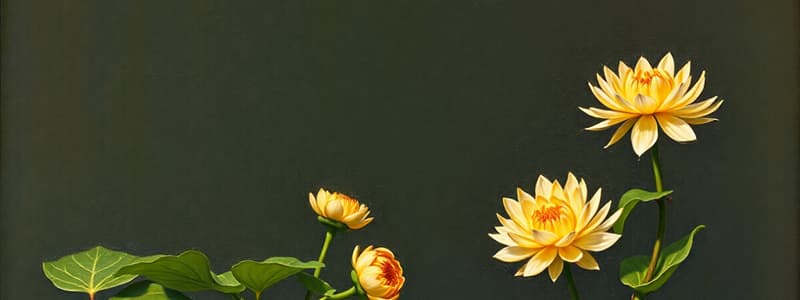Podcast
Questions and Answers
Compounds are unique to only one species or family of __________.
Compounds are unique to only one species or family of __________.
organisms
These compounds, which are classified as 'secondary metabolites', exclude amino acids, proteins, carbohydrates, lipids, and __________.
These compounds, which are classified as 'secondary metabolites', exclude amino acids, proteins, carbohydrates, lipids, and __________.
nucleotides
Anthocyanins impart red, blue, or purple colors to most fruits and __________.
Anthocyanins impart red, blue, or purple colors to most fruits and __________.
flowers
Nesocodon mauritianus is known for its (E)-Nesocodin red __________.
Nesocodon mauritianus is known for its (E)-Nesocodin red __________.
The functional roles of natural products may include color for __________ attractants.
The functional roles of natural products may include color for __________ attractants.
The plant Nesocodon mauritianus produces a natural red nectar that serves as a visual signal for ______ pollinators.
The plant Nesocodon mauritianus produces a natural red nectar that serves as a visual signal for ______ pollinators.
Anthocyanins serve as ______, organic compounds that inhibit attack by insects and grazing animals.
Anthocyanins serve as ______, organic compounds that inhibit attack by insects and grazing animals.
The orchid Dendrobium sinense mimics a honeybee ______ to attract hornets for pollination.
The orchid Dendrobium sinense mimics a honeybee ______ to attract hornets for pollination.
Natural products often have no nutritional or structural function but may play roles in ______ or repulsion.
Natural products often have no nutritional or structural function but may play roles in ______ or repulsion.
Coloured nectar acts as a visual signal for attracting ______ pollinators.
Coloured nectar acts as a visual signal for attracting ______ pollinators.
Flashcards are hidden until you start studying
Study Notes
Chemical Characteristics of Natural Products
- Natural products are unique to specific species or families of organisms.
- They are classified as "secondary metabolites", distinct from "primary metabolites" like amino acids, proteins, carbohydrates, lipids, and nucleotides.
Biological Characteristics of Natural Products
- They lack nutritional or structural functions.
- They serve various roles:
- Color:
- Identification: Anthocyanins provide red, blue, or purple colors in fruits, flowers, and leaves, potentially acting as a sunscreen.
- Attraction:
- Pollinators: Pigments can attract pollinators.
- Predators: Certain colored secretions attract specific predators to protect against herbivores.
- Scent: Attract or deter organisms.
- Taste:
- Antifeedant: Compounds can deter herbivores.
- Color:
History of Pharmacognosy
- Mesopotamia: Clay models of the human body and early writing suggest understanding of medicinal plants.
- Ancient Egyptians: Extensive knowledge of medicinal uses of plants, including morphine from opium (Papaver somniferum).
- Greece and Rome: Detailed records of plants with medicinal properties, such as atropine and hyoscine from Atropa belladona (Solanaceae family).
- Ancient India: Documented over 1000 medicinal plants, including snakeroot for high blood pressure.
18th Century of Pharmacognosy
- Johann Adam Schmidt (1759-1809) Published "Lehrbuch der Materia Medica", a foundational work on medicinal plants and their properties.
- Carl Linnaeus: Developed a system for naming and classifying plants.
- Crude Drugs: vegetable or animal drugs that have undergone only collection and drying.
Era of Pure Compounds (1803 onwards)
- Morphine (1803) from opium ( Papaver somniferum) – Used to treat moderate to severe pain.
- Strychnine (1817) from Strychos nux-vomica- A pesticide, particularly for rat control.
- Quinine (1820) from cinchona bark – Effective treatment for malaria.
- Caffeine (1820) – Isolated from coffee beans by Friedlieb Ferdinand Runge, who also isolated quinine.
- Nicotine (1828) from tobacco – Addictive stimulant.
- Atropine (1833) from plants of the nightshade family – Anticholinergic medication used to treat low heart rate, reduce salivation, and bronchial secretions.
- Cocaine (1855) from the Coca plant – Addictive stimulant drug. Cocaine hydrochloride (Goprelto), an ester local anesthetic, was approved for medical use in the United States in December 2017.
19th Century
- The chemical structures of many isolated natural products were elucidated.
Studying That Suits You
Use AI to generate personalized quizzes and flashcards to suit your learning preferences.



